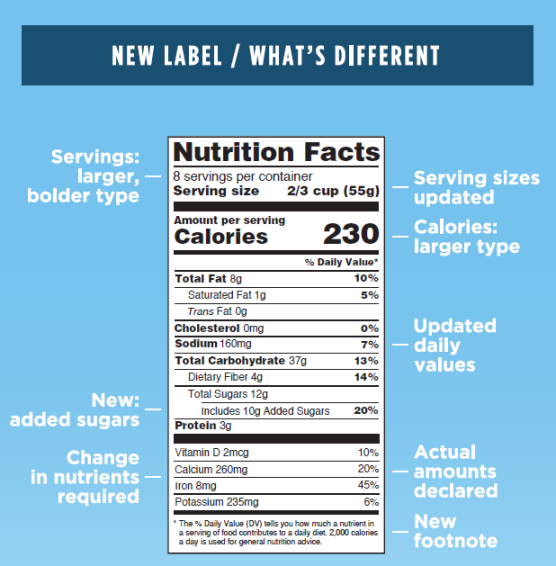White & Black chart on the side/back of your food package provides a lot of information about the food product & it really vital for you to know what is going inside your stomach. So how do you evaluate if a particular food offers right kind of macronutrients?
People should not get carried away by package advertising which may mention phrases such as “ low in fat”, “ low in sodium”, fiber rich”, “ no added sugar” etc. Companies use such tricks & advertising gimmick to portray their food products are healthier. They may be healthier than products offered by their competition, however they may misguide you by adding more sugar to make up for the fat they have removed or may add more salt or preservatives.
All this information is misleading & may lure you to buy the product. However, product label containing nutritional information does not lie. If you give clear attention to the information provided on food labels, you cannot be fooled by such advertising gimmicks
Nutrition fact table
Everyone knows about the facts mentioned on the nutritional label. However, most of them just give a glance to information & may read information about individual items such as gms of carbohydrates, protein, fat or total calorie content, but fail to go through the overall nutritional value.
Overall nutritional value of product is based on ratio of good & bad nutrients. You should not focus on evaluating the fact table to know which foods are healthy for you or finding a healthier choice between two or more products.
Below are certain things mentioned on facts table & related guidance on what to look for & what to avoid:
Serving Size
Serving size is a way by which companies may fool you to showcase that their product is healthier. The nutrition facts mentioned in the table are based on serving size however product package or contain generally have more than one serving. Sometimes the companies may try to misguide you by making the serving size half or quarter of the package & if you do not pay attention, you may end up consuming double or triple nutrients. Always pay attention to serving size & how many servings are there in the package.
Calories
Calories is unit of measurement & not a nutrient. 1 gm of protein/carb has 4 calories & 1 gm of fat has 9 calories. However the facts table mention about total calories without detailing calories contributed by each macro. This is the reason you cannot judge a good by calories alone.
Fats
Most of us consider fat as primary source of putting on weight. However, fat provides essential nutrients to the body. So it is important to evaluate the constitutes of fats. Saturated & trans fats are bad fats. Trans fats are even worse. Saturated fats are good to go in moderation, but ideally you want to consume as much good fat as possible. Focus on consuming more of polyunsaturated & monounsaturated fats which contains omega fatty acids.
Cholesterol
Your body makes its own cholesterol so dietary cholesterol is not that necessary however small amount of cholesterol does not do harm. High cholesterol is generally found on saturated & trans fat & hence focus on consuming less of those
Sodium
Sodium is essential for your body. However most of us ending consuming double of daily sodium intake which increases risk of blood pressure. There exists a lot of added sodium specifically in products where they advertise less sugar/fat content
Carbohydrate
Most of us consider carbohydrates as bad since it is made up of chains of glucose & once consumed gets converted into sugar in the body. Complex carbohydrates such as high starch in wheat & grain products are slowly digestible & would not spike your sugar level as much as processed & simple sugar
Fiber
Both soluble & in-soluble fibers are indigestible carbohydrates which is considered as great for digestive system & metabolism. It also lowers cholesterol level.
Protein
Protein contains several amino acids which are essential for repair & building of muscles & tissues & helps perform various essential body functions.
It is pretty awesome to know about basics of each component mentioned on the nutritional table. But equally essential is to evaluate how much is too little or too much. The best way to do so is to check % of daily value mentioned on the table along with the nutrients. The basic rule you should follow is 5% or less for sodium, cholesterol, saturated & trans fat & sugar & 15% or more for polyunsaturated & monounsaturated fats & fiber. If you follow this rule, you can be sure of making healthier consumption choices.
